
Wall Street and then (of course) our stock market are in the pullback zone that often happens in the scariest month of all, which is September. I know a guy who once sold all his stocks in the month — and he had a lot. He called the brokerage the cost of the sale and the buyback in October the “insurance”!
It’s really been a week of worry about whether the Fed could still raise rates. This is because the US run of economic data looks more buoyant than ours, and therefore it’s more likely that inflation will fall nicely here, explaining why our dollar has fallen against the greenback.
The rising rates possibility also explains why tech stocks and the Nasdaq have copped it over most of this week. The tech index was down about 2.7% for the week and has been flat for the past month. However, on a six-month basis, it’s up 18.7% and 32% year-to-date. As I’ve been warning you, on those numbers, a pullback or even a correction is possible in September-October, but then the December quarter’s historical positivity is likely to change everything.
However, it will depend on the run of upcoming economic data and what the market expects the Federal Reserve to do, rates-wise. “People were hoping the Fed would be on hold for the rest of the year, but it’s possible that we’ve got one or two more rate hikes to come,” said Chris Zaccarelli, chief investment officer at Independent Advisor Alliance on CNBC earlier this week. “All things being equal, that’s a little bit of a negative for the stock market, which was expecting the Fed to potentially be done for the year.”
And that’s why US stocks have dived this week and why our market was off 1.67% (or 121 points) over that time.
On the subject of data, Wall Street didn’t like the weekly jobless claims, which came in at 216,000, versus the 230,000 expected by the Dow Jones survey, while second-quarter labour costs rose more than anticipated. Not helping has been the recent rise in the price of oil and this Fed rate rise anxiety, which partly explains the stocks sell-off.
Right now, 93% of traders think September’s Fed meeting will bring a pause in rates but only 55% can see one in November. These views are based on what’s expected for US inflation and the concerns about a 2024 recession. It’s the classic bulls versus bears debate that dominates stock market forecasting and this week the bears have the upper hand. But will it last?
Friday on Wall Street brought guarded optimism, with tech regaining some friends but it wasn’t convincing. In the last hour, pessimism was beaten, but the Nasdaq only just snuck into the green at the closing bell. So next week’s economic data will be crucial to how stocks perform. On Wednesday, the Consumer Price Index will be poured over. If it’s a good low number, the market will look for worrying trends (that’s what they do!). If it’s a bad CPI number, it will instantly trigger a sell-off. (On Monday, I’ll look at the risks of buying into this recently sold-off market early next week ahead of that CPI number in the States.)
This from Bryce Doty, a senior vice president and portfolio manager at Sit Investment Associates, sums up the trading views of many players in US share markets right now. “When you think of the economy, it’s a Catch-22 for investors,” he told CNBC. “If it looks like we’re going to avoid the hard landing, we get some good economic news, and there’s a sigh of relief quickly followed up by an increased expectation of Fed rate increases”.
Tom Lee, head of research at Fundstrat Global Advisors, is often bullish but sees the current sell-off as a buying opportunity. I agree but the next few weeks of US economic data will determine if buyers now make their money sooner or later.
To the local story, and (as I said above) the S&P/ASX 200 lost 1.67%. BHP and Rio were off between 2-3%, with China not helping the iron ore price and their share prices. Adding to the gravitational pull on the share price was the fact that BHP went ex-dividend on Thursday.
On the other hand, lithium darling, Liontown Resources had another great week with a bigger offer on the table that the board is keen to support.
Here are the big winners and losers of the week, thanks to Bloomberg and the AFR.
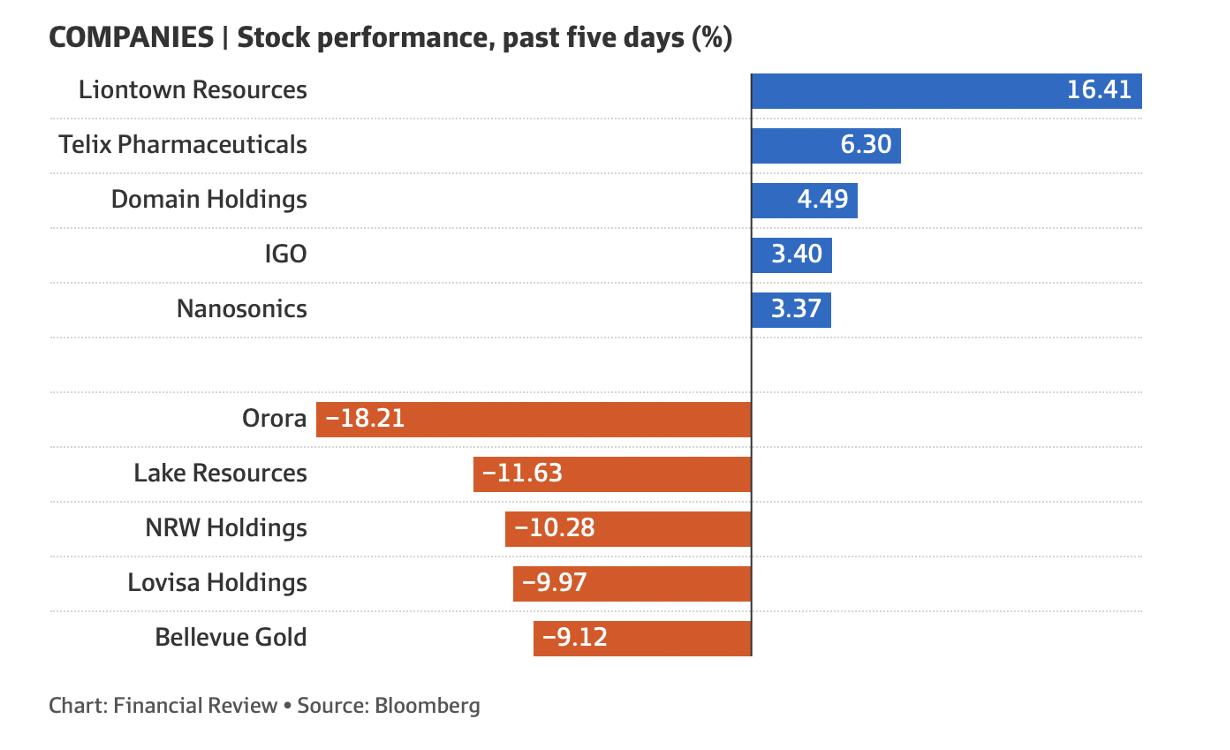
Orora’s dumping (see the drop in the chart above) follows the company completing a $1.3 billion equity raise to bankroll a buyout of France’s Saverglass. (Paul Rickard will look at this company’s prospects on Monday.)
Here are the sectors that did well on Friday. I like the positive move for the healthcare sector given I like CSL, Ramsay and Resmed. These might be early days in an overdue comeback.
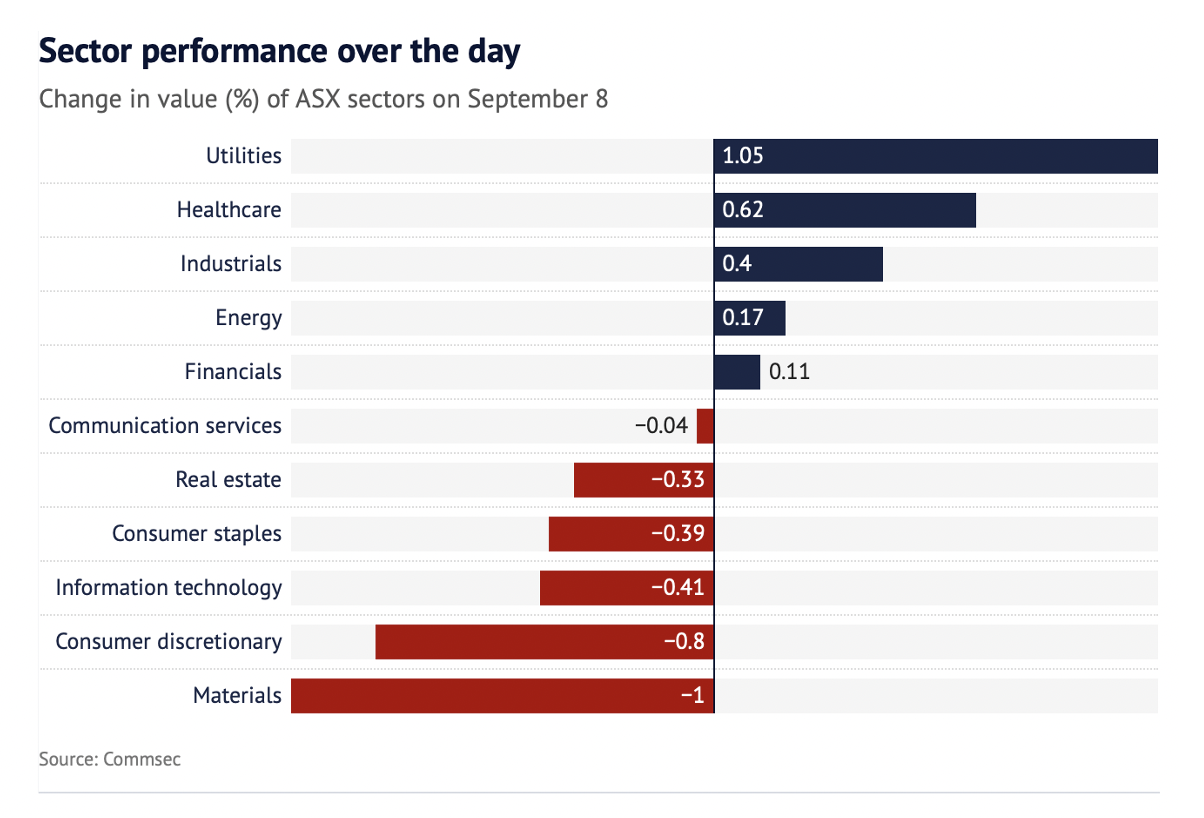
What I liked
- Economic growth has slowed to 0.4% for the June quarter and 2.1%, which means the RBA can stay on hold with rates and we don’t look like we’re in line for a worrying recession.
- Private demand was weak, showing the 12 rate rises are working.
- This from Shane Oliver after the National Accounts were released: “We continue to see the RBA leaving rates on hold ahead of rate cuts next year.”
- The RBA Board held the cash rate steady at 4.1% in September, the third consecutive on hold decision and the CBA said it expects the next move to be down!
What I didn’t like
- Company profits are now falling as a sharp fall in export prices (following last year’s energy boom) hit resources profits. This will impact national income and tax payments to Canberra, which will likely contribute to the budget sliding back into deficit. This is the rough consequence of big interest rate rises that I don’t like.
- This on productivity: “Productivity growth is unlikely to be as bad as it looks but is still a big concern. The RBA has noted that wages growth is consistent with the inflation target but only if productivity picks up.” (Shane Oliver, AMP)
- The services ISM survey in the US unexpectedly rose to a solid reading of 54.5. That said, the services PMI (which is a competing business survey) slowed to a soft reading of 50.5. A strong US economy increases the belief that the Fed will keep hiking rates, which is why the Oz dollar fell this week.
- Eurozone retail sales fell 0.2% in July and German factory orders fell 11.7% month-on-month in July, with industrial production down 0.8% month-on-month, with Europe looking at greater risk of recession than the US.
- The Caixin services conditions PMI in China fell more than expected in August, confirming the services sector slowdown is already evident in the official services PMI. We need China to rebound!
- The Melbourne Institute’s Monthly Inflation Gauge picked up to 6.1% year-on-year in August, but I don’t rate this as a reliable indicator. That said, I can’t like what it’s saying.
My Stocks Rule of 10 for investing
Clearly, my story today argues that it will be economic data that determines the timing of a stronger recovery of stocks. In the short run, it’s a bigger gamble to hope that inflation will fall enough to please the Fed, and, as we all know, hope isn’t a strategy. However, if you can lose money short term to win long term, hope isn’t a factor. The magnitude of interest rate rises will beat down inflation and when that’s clear, stocks will rise. And that’s when we make money.
I have one important message: Keep the faith that my Rule of 10, that stocks rise 7-8 years out of 10, and overall, stock markets average a 10% return per annum over a 10-year period.
The Week in Review
Switzer TV
- Switzer Investing: SwitzerTV Monday 4th September 2023
- Boom Doom Zoom: 7th September 2023
Switzer Report
- 2 dividend yield opportunities
- “HOT” stock: Karoon Energy (KAR)
- Questions of the Week
- Be greedy when others are fearful
- Modest losses for our portfolios in August as market digests reporting season
- HOT stock: MINERAL RESOURCE (MIN)
- 3 stocks under 50 cents
- Buy, Hold, Sell — What the Brokers Say
Switzer Daily
- Slow down, you move too fast Burkey
- Beware! Treasurers around the country have their eye on your hip pocket and they’ll shrink it if they can!
- Au revoir, Dr Phil. We hope you’ve gifted us a soft landing
- What’s at the back of Burke’s $9 billion industrial relations bombshell?
- Will Treasurer Jim’s money support for low income Aussies be inflationary and stop rate cuts?
The Week Ahead
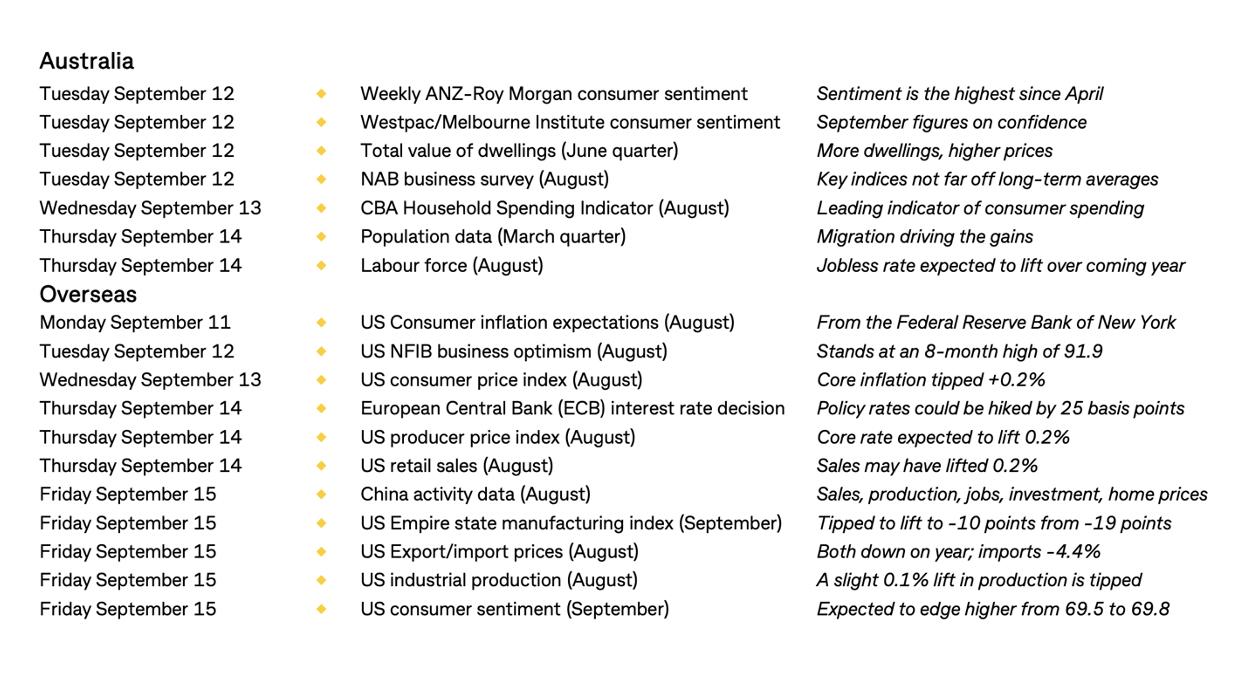
Top Stocks — how they fared.
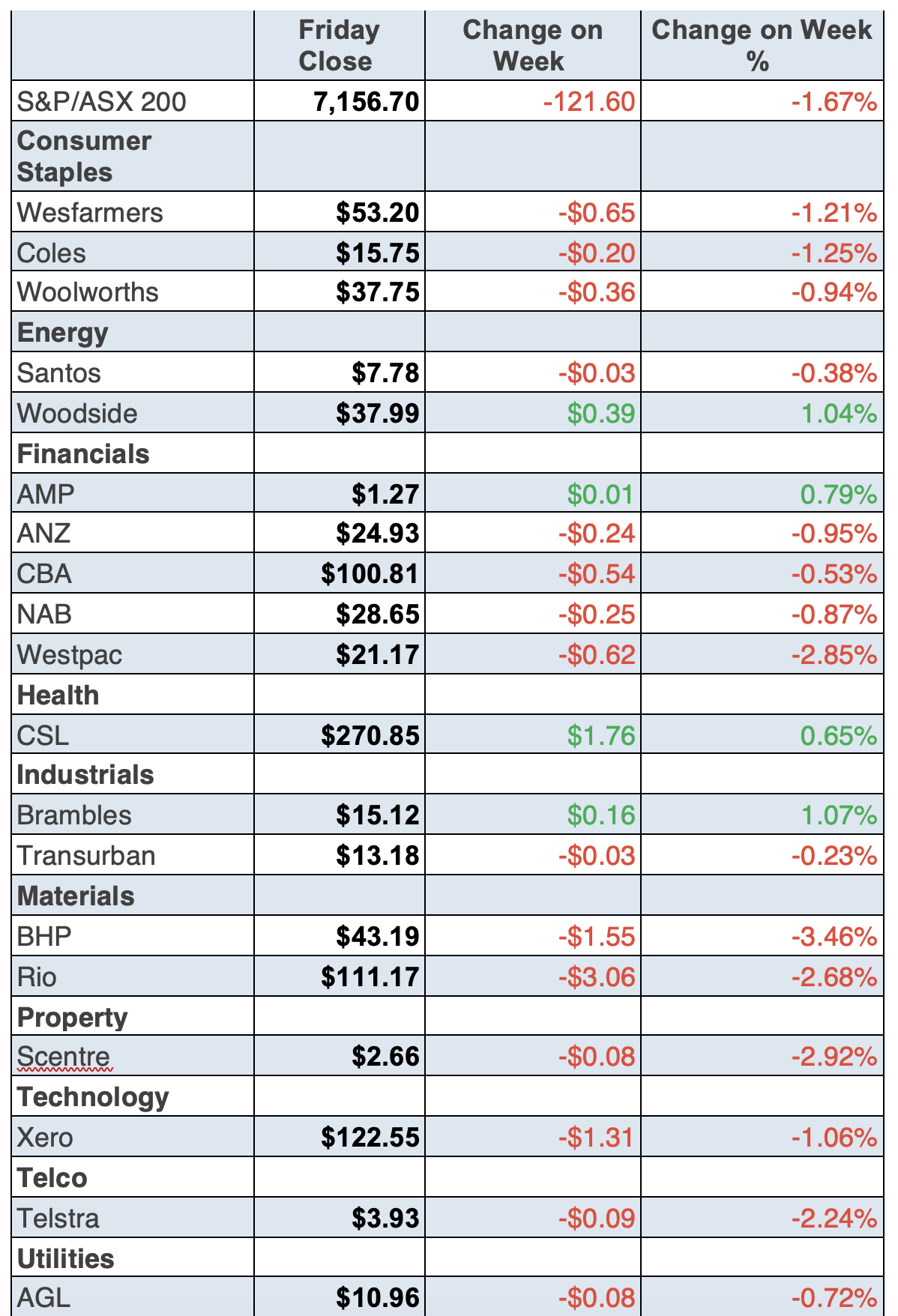
Chart of the Week
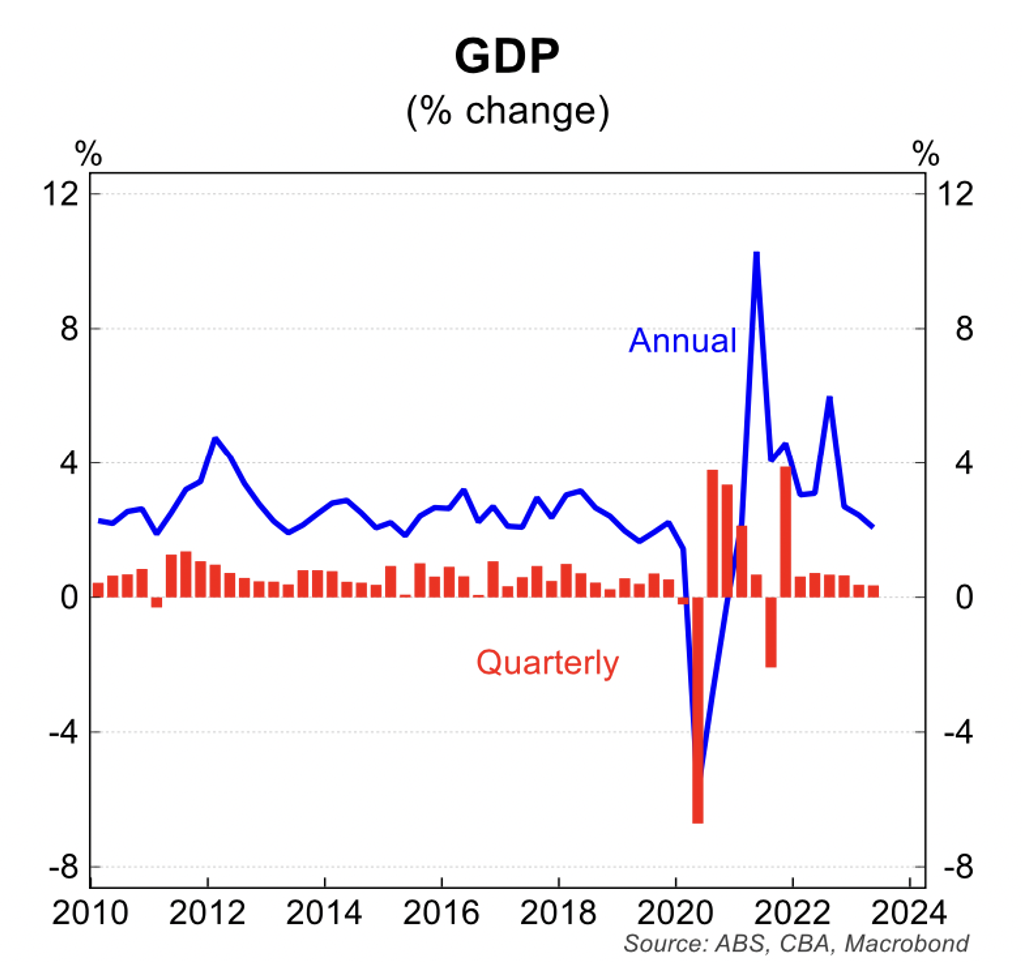
CBA economics team says: “The Australian economy grew by 0.4% in the June quarter, the same rate of growth as the (upwardly revised) March quarter. The pace of annual growth sits at 2.1%, below the pace of trend growth and below the estimate of the current rate of population growth at ~2.8%.”
My view: This growth rate is slow enough to help inflation fall and stop the RBA from raising rates anytime soon.
Stocks Shorted

ASIC releases data daily on the major short positions in the market. These are the stocks with the highest proportion of their ordinary shares that have been sold short, which could suggest investors are expecting the price to come down. The table shows how this has changed compared to the week before
Quote of the Week
This one from AMP’s Shane Oliver is long but is worth a read: “The list of threats to share markets in the near term remains long: there is a high risk that the disinflation process could pause and August inflation data in Asia and Europe has highlighted this; many central banks, including the RBA and Bank of Canada in the past week, are warning that they could still raise rates further; the risk of recession remans high; the continuing rebound in oil prices on the back of Saudi and Russian production cuts adds to inflation and recession risks; China’s economy is still at risk with no further policy stimulus; there is a high risk of another US Government shutdown from 1 October if US politicians fail to agree a budget or continuing resolution this month and any resolution is likely to involve tighter US fiscal policy; surging US student loan payments are an additional drag in the US; high bond yields are pressuring share market valuations; geopolitical tensions are continuing with China planning to extent its ban on iPhone use to government agencies and state companies; and the weak seasonal period for shares goes out to October. However, our 12-month view on shares remains positive as inflation is likely to continue to trend down taking pressure off central banks and any recession is likely to be mild.”
Disclaimer
Important: This content has been prepared without taking account of the objectives, financial situation or needs of any particular individual. It does not constitute formal advice. Consider the appropriateness of the information in regards to your circumstances.

